THE VOICE, THE EXHIBITION THAT SPEAKS TO YOU

The voice is our main method of communication with others and the vector of language. It expresses our emotions and it is our oldest musical instrument. But do we know how it works? Research on voice involves physics, acoustics and cognitive science. Our intention is to present the complexity and different aspects of the voice.
This exhibition is suitable for all people age 8 and over. Visitors - who are both the creators and the subjects of experiments - can explore, test and alter their own voice. They can also record their voices and compare them to others', and discover the mechanisms involved in speech and singing.
The exhibition is divided into 3 parts, with various interactive and fun exhibits:
- Body and Voice: Chorus of Four Larynxes, Voice Transformation, Transforming Voices, Sonagrame, Vocal Apparatus Puzzle, Phonetogram, Exploring the Vocal Tract.
- Expression and Voice: Voice of the World, Voice and Identity, Recognizing Emotions in Speech.
- Art and Voice: Sing with a Virtual Choir, Singing Voice Synthesis and Transformation, Quiz of Well-known Voices
Voice and Body
Human voices vary spectacularly. They can be atonal or melodic, soft or thundering, crystal clear or husky. To find out why, we need to take a closer look at the fabulous instrument that allows us to yell, sing and speak. This instrument not only includes larynx and lungs, it uses the whole body. The vocal apparatus controlled by ears and brain emits sounds that it articulates, paces and modulates to produce speech and singing.

Chorus of Four Larynxes
To use our voice in the same way as we play a musical instrument, we need: energy to produce breath (respiratory tract); something that vibrates (vocal cords); resonators to shape and amplify the sound (oral, nasal and nasopharyngeal cavities). Along with vocal cords and larynx - a vital organ in phonation - is the vocal source that produces the laryngeal flow (complex periodic sound) behind voiced sounds.

Voice Transformation
An IRCAM video explains the technology to synthesize and modify voices that are increasingly used in films and plays. For instance, Gérard Depardieu's English accent was adjusted in the film Vatel. Another example comes from the theatre, where a voice generated in real time is used to represent an actor's alter-ego. The video also shows that voice can be multiplied, or instantly turned into another character's voice or a singing voice.

Transforming voices
Variations in the voice are caused by the modification of its three main acoustic qualities: volume, pitch and timbre. Timbre especially is a very important characteristic which different in each voice. It results from the transformation and modeling of the laryngeal sound by the resonant cavities and so depends on their anatomy. This is why vocal characteristics vary greatly depending on age and sex. Visitors record their voice, play it back and change it, using the 2 buttons to make it more feminine or masculine and/or make it sound older or younger.
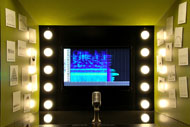
Sonagrame
How can you see your voice? The spectrogram or sonogram displays all the harmonics contained in the voice (singing or speaking). The coloured lines on the screen correspond to these harmonics. The time (in seconds) is shown on the horizontal axis and the frequency of the harmonics (in Hertz) on the vertical axis. The frequency and amplitude of certain harmonics determine the perceived pitch (high or low) of the voice and its timbre (clear or husky, smooth, nasally, etc.). The system also allows visitors to visualize their prosody, i.e. the way they pronounce words: rhythm, pace, emphasis, frequency modulation, etc.
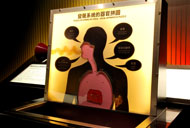
Vocal Apparatus Puzzle
Sound production involves entire body, not just vocal apparatus. There are 7 parts in the tray and each will represent an element of our vocal apparatus. You are asked to place them in the right positions. When a part is positioned correctly, its caption will light up. When the whole puzzle is finished, an amusing successful signal will sound.
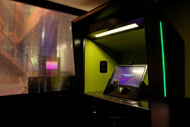
Phonetogram
The phonetogram explores the vocal range of the speaking or singing voice. It is used to test the potential of a voice in the same way that an audiogram is used to test hearing. Frequencies (in Hertz) are on the horizontal axis and volumes (in decibels) on the vertical. The system is used in various forms by speech pathologists, therapists and singers. The exhibition phonetogram developed with the LAM workshops enables visitors to identify the limits of their vocal range. This means they can then compare their phonetogram with those of professional singers and find out whether they are mainly soprano, alto, tenor or bass.
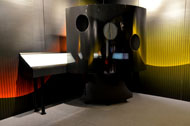
Exploring the Vocal Tract
For 15 years or so, medical imaging techniques such as fibroscopy have been used to study the vocal apparatus. More recently, the Tele-video Laryngoscopy has enabled us to "see" speaking and singing voices in action and at rest with precision and without affecting speech articulation.
Expression and Voice
There is no scientific proof that any particular voice is unique - no evidence for a vocal signature, let alone a vocal "fingerprint". However, our voice reveals a lot about our identity - where we come from, our background and education. It also expresses our mood, state and intentions. Our voice reveals things about us, but we can also learn to control it to improve our expression and communication skills.

Voice of the World
Everyone has his vocal music. Throughout the ages and over the continents, human beings have used a wide variety of vocal techniques from simple wails to complex polyphonies, including calls, shouts, playing on timbre and register, imitating instruments, disguising their voices, etc. Europe has developed its specific singing art and every other continent and culture has its own - Lnuit throat singing, African yodelling, Siberian diphonic song, trance voices, the mixture of singing and declamation used in Asian theatre, etc.
Remark: Exhibit produced jointly with the CREM (Centre for Ethnomusicological Research) and Gilles Léothaud, Teacher of Ethnomusicology.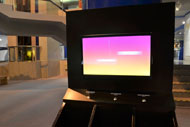
Voice and Identity
For decades now, IRCAM has been conducting research to learn how to change the identity of voices. Such techniques are about the voice of people who are dead or gone, for example, do automated voice casting, copy a voice, make it say things it has never said, change its characteristics, prosody and emphasis, and even change it completely into somebody else's voice. A video shows various applications in this area and the ethical questions they may arise in the future.
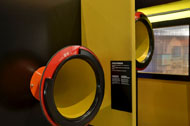
Recognizing Emotions in Speech
Emotions can colour the voice and so modify the meaning of the phrase. For instance, anger makes the heart beat faster, dries the mouth and changes the voice: modifying its pace and degree of articulation, and even its fundamental frequency or basic tone. Yet it is quite difficult to recognize someone's emotions or intention simply by listening to the tone of their voice if we cannot see their facial expression. Why? As we speak, we also use non-verbal language: looks, signs and gesture. That is what specialists call the multimodality of speech.
Art and Voice
Every people have developed its vocal techniques: speech, discourse, song, etc. The voice is the original instrument of human music - an infinitely various instrument whose rich multiplicity never ceases to fascinate and surprise us. With drama and singing, we enter the world of performance. Actors and singers are trained for a long time to control their voice. It must be regulated to make it clearly audible, with or without a microphone. It must also convey emotions through a text or music, bringing characters to life and enthral audiences.
In this part of the exhibition, you will listen to famous great voices and find out about the rich history of songs, from Gregorian chants to be canto, and jazz to rap.
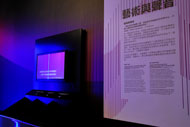
Sing with a Virtual Choir
The visitor enters a "shower compartment", where they are asked to sing after selecting different parameters: profile of the choir (number and type of choristers), type of reverberation (cellar, shower, cathedral and open-air), and mode (minor or major). They then hear their voice directly, augmented by a virtual choir that accompanies their singing.
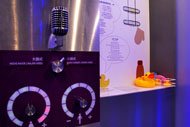
Singing Voice Synthesis and Transformation
Since the end of the 1970s, IRCAM research into the synthesis and modification of singing voices has led to number of spectacular achievements. Among them are the Gérard Corbiau's film "Farinelli"and the Philippe Manoury's opera "K" with its virtual choir. A video presents Ircam's research and shows various techniques for synthesizing and transforming the singing voice. Explanations provided by an expert are supported by concrete examples of applications, extracts from shows and films, etc.
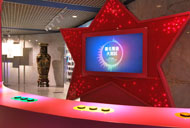
Quiz of Well-known Voices
Voices are infinitely diverse. Every human being has his or her own unique voice. Let us see whose voice you can remember well. This is an interactive game for five participants to compete. When a song is presented, participants must press the button to choose the best answer from 3 options provided. At the end of the game, each participant is given his or her score.